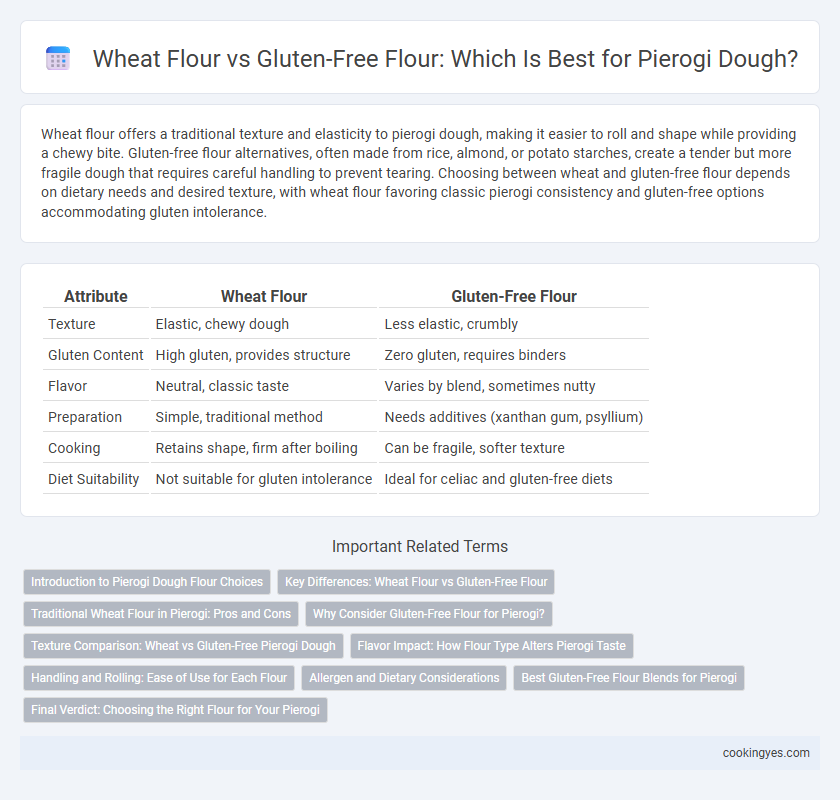Wheat flour offers a traditional texture and elasticity to pierogi dough, making it easier to roll and shape while providing a chewy bite. Gluten-free flour alternatives, often made from rice, almond, or potato starches, create a tender but more fragile dough that requires careful handling to prevent tearing. Choosing between wheat and gluten-free flour depends on dietary needs and desired texture, with wheat flour favoring classic pierogi consistency and gluten-free options accommodating gluten intolerance.
Table of Comparison
| Attribute | Wheat Flour | Gluten-Free Flour |
|---|---|---|
| Texture | Elastic, chewy dough | Less elastic, crumbly |
| Gluten Content | High gluten, provides structure | Zero gluten, requires binders |
| Flavor | Neutral, classic taste | Varies by blend, sometimes nutty |
| Preparation | Simple, traditional method | Needs additives (xanthan gum, psyllium) |
| Cooking | Retains shape, firm after boiling | Can be fragile, softer texture |
| Diet Suitability | Not suitable for gluten intolerance | Ideal for celiac and gluten-free diets |
Introduction to Pierogi Dough Flour Choices
Pierogi dough traditionally relies on wheat flour, prized for its gluten content that ensures elasticity and a tender, chewy texture essential to authentic pierogi. Gluten-free flour blends, often combining rice flour, tapioca starch, and potato starch, serve as alternative options catering to those with gluten sensitivities or celiac disease. Choosing the right flour type directly impacts dough pliability, cooking performance, and the overall bite of the pierogi, making flour selection a crucial decision in pierogi preparation.
Key Differences: Wheat Flour vs Gluten-Free Flour
Wheat flour contains gluten, a protein that provides elasticity and chewiness to pierogi dough, resulting in a soft yet durable texture. Gluten-free flour blends, often made from rice, tapioca, or potato starch, lack this binding property, requiring added binders like xanthan gum to achieve similar dough elasticity. The choice between wheat and gluten-free flour affects dough handling, texture, and cooking outcomes, with gluten-free variants typically yielding a more delicate and crumbly pierogi.
Traditional Wheat Flour in Pierogi: Pros and Cons
Traditional wheat flour is the most common choice for pierogi dough, offering a smooth texture and elasticity that make the dough easy to roll and shape. Its gluten content provides the necessary structure and chewiness, resulting in classic pierogi with the ideal bite and firmness. However, wheat flour can be problematic for individuals with gluten intolerance or celiac disease, limiting its accessibility for those seeking gluten-free alternatives.
Why Consider Gluten-Free Flour for Pierogi?
Gluten-free flour is essential for making pierogi accessible to individuals with celiac disease or gluten sensitivity, ensuring they can enjoy this traditional dish without adverse health effects. Unlike wheat flour, gluten-free alternatives such as rice flour or tapioca starch offer a suitable texture while eliminating gluten-related digestive issues. Using gluten-free flour preserves the pierogi's tender and chewy consistency, catering to dietary restrictions without compromising flavor or authenticity.
Texture Comparison: Wheat vs Gluten-Free Pierogi Dough
Wheat flour pierogi dough offers a tender yet elastic texture due to its gluten content, which provides the necessary stretch and chewiness for traditional pierogi. Gluten-free flour blends often result in a denser, slightly crumbly texture that may lack the elasticity found in wheat-based dough, requiring binders like xanthan gum to improve pliability. Choosing between wheat and gluten-free flour significantly affects the softness and durability of the dough during cooking and handling.
Flavor Impact: How Flour Type Alters Pierogi Taste
Wheat flour provides pierogi dough with a traditional, slightly nutty flavor and a tender yet chewy texture that enhances the overall taste experience. Gluten-free flour blends, often made from rice, tapioca, or potato starch, produce a milder and sometimes slightly grainy flavor, which can result in a lighter but less elastic dough affecting taste perception. Choosing between wheat and gluten-free flour significantly influences the pierogi's mouthfeel and flavor depth, making the flour type a key factor in authentic taste replication.
Handling and Rolling: Ease of Use for Each Flour
Wheat flour pierogi dough offers elasticity and strength, making it easier to roll thin without tearing, ideal for traditional preparation. Gluten-free flour blends often require additional binders like xanthan gum, resulting in a more delicate dough that can be prone to cracking and challenging to handle during rolling. Mastery of gluten-free dough requires gentle handling and frequent flour dusting to prevent sticking and maintain dough integrity.
Allergen and Dietary Considerations
Wheat flour, rich in gluten, provides elasticity and chewiness essential for traditional pierogi dough but poses allergen risks for those with celiac disease or gluten intolerance. Gluten-free flour blends, often based on rice, potato, or tapioca starch, offer safe alternatives catering to gluten-sensitive diets while requiring adjustments in hydration and kneading techniques to achieve similar texture. Selecting the appropriate flour is crucial for accommodating dietary restrictions without compromising pierogi quality.
Best Gluten-Free Flour Blends for Pierogi
Best gluten-free flour blends for pierogi dough often combine rice flour, tapioca starch, and potato starch to mimic the elasticity and tenderness of traditional wheat flour. A blend with xanthan gum or guar gum enhances dough elasticity, making the pierogi easier to roll and fold without cracking. These blends provide a balanced texture that holds fillings well while maintaining the characteristic softness of classic pierogi dough.
Final Verdict: Choosing the Right Flour for Your Pierogi
Wheat flour offers elasticity and chewiness essential for traditional pierogi dough, providing a reliable structure that holds fillings securely during cooking. Gluten-free flour blends, often made from rice, tapioca, or potato starch, serve as suitable alternatives for gluten-sensitive individuals but may result in a more delicate, less elastic dough requiring careful handling. For authentic texture and durability, wheat flour remains the preferred choice, while gluten-free options provide a viable solution for dietary restrictions without compromising flavor.
Wheat Flour vs Gluten-Free Flour for Pierogi Dough Infographic

 cookingyes.com
cookingyes.com